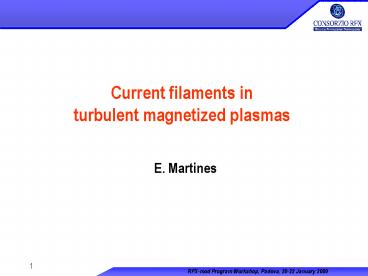Current filaments in - PowerPoint PPT Presentation
1 / 17
Title:
Current filaments in
Description:
Turbulent transport in fusion plasmas is intermittent, because it is dominated ... have been observed in the magnetosphere by the 4-spaceship Cluster mission. ... – PowerPoint PPT presentation
Number of Views:32
Avg rating:3.0/5.0
Title: Current filaments in
1
Current filaments in turbulent magnetized plasmas
E. Martines
2
Introduction
Turbulent transport in fusion plasmas is
intermittent, because it is dominated by the
contribution of coherent structures. Coherent
structures (blobs) are usually identified through
their electrostatic features (potential or
density structures). However, at the ? values
found in the edge of fusion devices,
electromagnetic features are expected. This is
the main (but not exclusive) motivation for
looking for current filaments. A good ground for
comparison with other plasma physics branches.
3
Phenomena where current filaments appear
- Coherent structures in RFP edge microturbulence
(small scale) - Coherent structures in magnetospheric turbulence
(small scale) - Reconnection events associated to RFP sawteeth
(large scale) - Reconnection events in the magnetosphere (large
scale) - ELMs in tokamaks (large scale)
- ... and certainly many others!!
4
Current filaments in RFP microturbulence (1)
Diagnostic U-probe, a complex probe equipped
with triple probes (n, Te, ?p) and magnetic
probes (Br, B?, B?). In particular, we can
compute
- Data analysis technique
- wavelet transform to select structures at a
given scale - conditional averaging.
5
Current filaments in RFP microturbulence (2)
- Structures at ? 3.3 ?s (L? 5 cm)
- Electron pressure/density peak
- Potential well on density peak
- Parallel current density peak
- The pressure structure has a
- radial extension of 2-4 ?s (1-2 cm).
- The current density structure
- has an amplitude of a few
- of the average j, and a toroidal
- size of 100 ?s (30-40 cm) due to the stretching
effect of the velocity shear.
6
Current filaments in RFP microturbulence (3)
The magnetic field and E?B hodograms in the
perpendicular plane display closed patterns,
corresponding to the effect of current density
and vorticity filaments, The vE?B perturbation
matches the Alfvén velocity one. ? Alfvénic
structures
7
Current filaments in RFP microturbulence (4)
The current density filament is associated to a
parallel vorticity peak, i.e. the fluid rotates
in the perpendicular plane. All these results,
taken together, allow to identify the detected
structures as Drift Alfvén vortices
M. Spolaore et al., Direct measurement of
current filament structures in a magnetic
confinement fusion device, submitted to Physical
Review Letters. N. Vianello et al., Observation
of drift-Alfvén vortices in a laboratory plasma,
submitted to Nature Physics.
8
Drift-Alfvén vortices in the magnetosphere
Drift-Alfvén vortices have been observed in the
magnetosphere by the 4-spaceship Cluster mission.
D. Sundkvist et al., Nature 436, 825 (2005).
9
Current sheets in RFP sawtooth crashes (1)
Sawtooth crashes in RFPs are accompanied by a
growth of m1 modes, with an energy cascade
towards higher n. Subsequently, the m1
amplitude drops and energy is transferred to a
localized m0 magnetic perturbation, which is
formed at the locking position and then starts to
rotate.
10
Current sheets in RFP sawtooth crashes (2)
Using the U-probe, the passage of the m0
perturbation has been associated to a parallel
current density perturbation, which can be
identified as the current sheet associated to the
reconnection event.
11
Current sheets in RFP sawtooth crashes (3)
The perturbation amplitude decays exponentially
as it moves toroidally, with a time constant of
about 400 ?s. Considering the magnetic field
diffusion equation and neglecting the
convection term, this yields an upper limit to
the radial size of the structure of about 6
cm. The toroidal dimension of the current sheet
is of the order of 2 m.
M. Zuin et al., Plasma Phys. Control. Fusion 51,
035012 (2009).
12
Current sheets in magnetosheath reconnection
Current sheets have been measured by the Cluster
mission in reconnection events occurring in the
bow-shock region of the magnetosphere. The sheet
thickness is ?i, i.e. 100 km.
A. Retinò, D. Sundkvist et al., Nature Physics 3,
235 (2007).
13
Current filaments during ELMs in tokamaks (1)
Plasma filamentation during ELMs is observed in
many tokamaks.
14
Current filaments during ELMs in tokamaks (2)
Three components of B measured by an insertable
probe during type I ELMs in ASDEX-Upgrade. Low-fr
equency (lt 20 kHz) fluctuations are analysed
using the Degree of Polarization (DOP) technique
looking for coherent structures. ELMs exhibit
multiple peaks in Isat (density) and increased
magnetic activity, with a drop in DOP indicating
the presence of coherent structures.
15
Current filaments during ELMs in tokamaks (3)
3D hodograms (Br- B?-B? plots) display elliptic
closed trajectories, lying in a plane which is
found to be perpendicular to the average magnetic
field. This is the signature of field-aligned
current filaments.
N. Vianello, R. Schrittwieser, V. Naulin et al.,
Direct observation of current in ELM filaments
on ASDEX Upgrade, to be submitted to Physical
Review Letters.
16
Summary
- Through the use of insertable probes
- Turbulent structures in the RFP outer region have
been identified as drift-Alfvén vortices, similar
to those observed in the magnetosphere. - The formation of large scale current structures
during reconnection events in RFPs has been
clearly measured. - Current filaments in tokamak ELMs, possibly
caused by the peeling-ballooning mechnism, have
been measured for the first time.
17
Outlook
- RFX-mod can contribute to the study of current
filaments through - Further studies with probes at low current in RFP
discharges. - Studies with probes at higher current (requires
fast manipulator). - Studies of turbulent structures in tokamak and
ULQ discharges.































